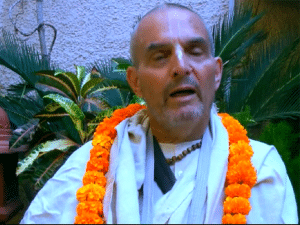Prabhupada's daily schedule
Hari Sauri Dasa: It is hard to say when Prabhupada's day begins and when it ends, because he never seems to conclude his activities in the way we do. He only rests for a few hours each day, and even that is intermittent. Srila Prabhupada maintains a remarkably regulated daily routine. While here in Vrindavana his schedule is: 6:00 a.m.Wash, brush teeth, and take Ayurvedic medicine. 6:30 - 7:30 a.m. Morning walk. 7:30 - 8:30 a.m. Greet the Deities, guru-puja, then Srimad-Bhagavatam lecture from the Seventh Canto. 9:00 - 9:30 a.m. Breakfast of fruits and chira. 9:45 - 11:15 a.m. Rest on roof for an hour and then meet people (usually by appointment). 11:15 - 1:15 p.m. Massage with oil. 1:15 - 1:45 p.m. Bathe. 1:45 - 2:30 p.m. Lunch prasadam. 2:30 - 3:00 p.m. Sit in room or chant japa. 3:00 - 4:00 p.m. Rest. 4:00 - 5:00 p.m. Meet with specific people or devotees, or chant. 5:00 - 6:30 p.m. Give public darsana. 6:30 - 9:30 p.m. Meet public or senior devotees, GBC business or just chat. 9:30 p.m. Take hot milk, massage and rest. 12:00 - 1:00 a.m. Rise and translate. 5:00 a.m. Light rest or japa. Srila Prabhupada's typical routine goes something like today.
After his all-night translation work he stopped at mangala-arati time and lay back against the bolsters with his feet up. He slept lightly for a short time. At six o'clock he went into the bathroom to wash, brush his teeth, and freshen up. He came back and sat for a few minutes as he put on tilaka. When that was completed, he took a reddish Ayurvedic medicinal pellet called Yogendra-rasa. After I had crushed it with a large, roasted cardamom seed and then mixed it with honey in a small oval mortar, he added a little water. He drank the mixture straight from the mortar, scraping up the residue with the pestle, which he then deposited on his tongue with an elegant twist of his fingers. Then Prabhupada prepared to leave for his morning walk. Getting up from his desk he stood patiently as I helped him on first with his uttariya (the saffron top-piece traditionally worn by all sannyasis) then with his heavy saffron-colored coat and his woollen hat. I finally hung his bead bag around his neck.
All the while he conversed with Hansaduta, Akshayananda Swami, and Gopala Krishna. As he walked toward the door, I rushed ahead to place his cane directly into his hand. I then positioned his shoes so that he could step into them and out of his slippers in one easy movement, all while I was holding the door open. It is somewhat of an art to manage all this without delaying or interrupting Prabhupada's steady progress out. The expectant devotees waiting outside enthusiastically shouted, "Jaya Srila Prabhupada!" as he appeared, offering their obeisances and a garland. Smiling and modest, he returned their greeting with "Jaya! Hare Krishna!" The privileged few who went on the day's walk gathered closely around him as he made his way up the side of the temple and out the front gate onto Chattikara Road. Heading west into the countryside beyond the boundary of Vrindavana village we walked for exactly half an hour, as far as a solitary house named "Moda Place," and then back.
Prabhupada's gait is surprisingly swift and strong, and by the end we were struggling to keep up. At precisely seven thirty he entered the temple from the side door and waited patiently as the pujaris strained to swing back the immense wooden doors on each of the three altars. The conch shells trumpeted their call to the faithful, announcing the imminent appearance of the Deities. The curtains drew back, and the Govindam prayers boomed over the loudspeaker. Srila Prabhupada, followed by all the devotees, offered his prostrate obeisances first to his Guru Maharaja, Srila Bhaktisiddhanta Sarasvati, and Their Lordships Sri Sri Gaura-Nitai, then to the two moon like brothers Sri Sri Krishna-Balarama, and finally to the brilliant forms of Sri Sri Radha-Syamasundara. After taking a little caranamrita, Prabhupada walked across the black-and-white checkered marble floor and mounted the steps to his carved marble vyasasana. As he sat flanked by ornamental lions, the devotees offered guru-puja. Chanting the prayers "sri guru carana padma...," each devotee came forward to offer a flower to his lotus feet and bow before him. Everyone relished this opportunity to glorify Srila Prabhupada in person. It is a daily act of humble submission, an affirmation of our full commitment to his service and a reminder to our flickering minds that without him we are nothing. As the kirtana ended, Harikesa moved forward to swing the microphone around in front of Prabhupada's mouth.
Prabhupada's voice rang out over the loudspeakers, "Jaya om vishnupada paramahamsa parivrajakacarya ashtottara-sata sri srimad Bhaktisiddhanta Sarasvati Gosvami maharaja prabhupada ki jaya!" The devotees bowed their heads to the ground in obeisance to the disciplic succession, the Panca-tattva, the holy dhamas, the Vaishnavas, and all the assembled devotees. Then Harikesa passed Prabhupada his karatalas. We sat down to listen and respond to Prabhupada's sweet and melodious voice as he glorified Sri Sri Radha-Madhava: "Jaya radha madhavuhhh, kunjavi hari, gopi janaballabhaa girivaradhari; jasodanandana brajajana ranjana, jamuna tiiraaa banacaari." His eyes closed in concentration, his face showing the intensity of his meditation on the objects of his love and worship in the groves of Vrindavana on the banks of the Yamuna river. He infused new meaning and freshness into the song, though he sings it every day before class. His brass karatalas rang out, quickening the pace, and the devotees' voices swelled in response. Just as it came to a heart-filling crescendo, the karatalas gave their final three metallic rings, "dung dung dung," and everyone knelt with their heads to the floor as Prabhupada recited the prema-dhvani prayers again.
Reference: Transcendental Diary Volume 1 by Hari Sauri Dasa
Recently Added
Trending Today
